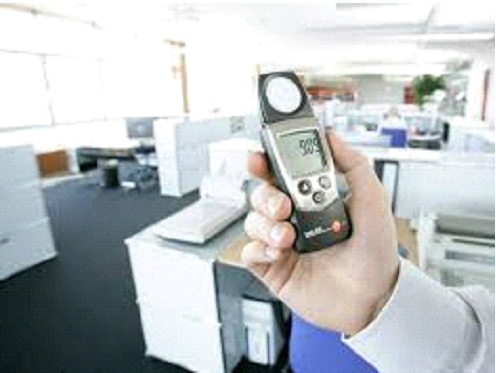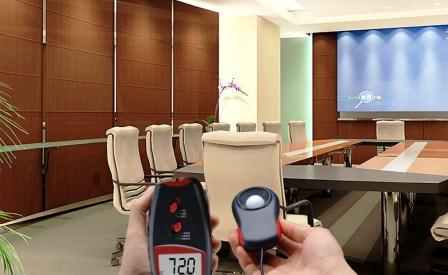Illumination Survey
Illumination Survey

Lighting Standards
As per Maharashtra Factories Rules 1963:
Standards of lighting of factories: (i) In every factory, where natural lighting is not such that day light conditions are fairly uniform over the working or other areas and/or daylight illumination is not sufficient, additional lighting, which shall be of uniform level, widely distributed to avoid hard shadows or strong contrast and free from direct or reflected glare, shall be provided. The minimum intensity of illumination for the different areas and work-rooms of the type given under column No. 2 shall be as given under column No. 3 of the schedule ‘A’ appended hereto:
(ii) Notwithstanding the above, in every factory, where intense local lighting is further necessary on account of the nature of work as mentioned in the column No. 2 of the Schedule ‘B’ appended hereto, the same shall be obtained by a combination of general lighting and supplementary lighting at the point of work. The minimum intensity of illumination for different tasks shall be as given under column No. 4 of the said schedule.
(iii) In case of any doubt or dispute in regard to the classification of areas or tasks specifically mentioned in Schedule ‘A’ or corresponding to the examples mentioned in Schedule ‘B’ respectively, the decision to the Chief inspector of Factories shall be final.
(iv) In regard to cotton ginning factories, where the electric power is not available and when additional lighting for the interior of the factory is necessary, the same shall be provided by the candles placed in glass lanterns of a pattern approved by the inspector and at the rate of not less than one such lantern for every two gins.
Schedule ‘A’
| Area and Work-room | ||
|---|---|---|
| Stock-yards, main entrance and exit roads, cat-walks of outdoor plants, coal unloading and storage areas | ||
| Passage-ways, and corridors and stairways, warehouses, stock-rooms for large and bulky materials, platforms of outdoor plants, basements | ||
| Engine and boiler rooms, passengers and freight elevators, conveyers crating and boxing departments, store-rooms and stock-rooms for medium and fine materials, lockers rooms, toilet and wash rooms. |
Schedule ‘B’
| Nature of work | Examples | ||
|---|---|---|---|
| Where discrimination of detail is not essential. | Handling of material of coarse nature, rough sorting, grinding of clay products, handling coal or ashes. | ||
| Where alight discrimination of detail is essential. | Production of semi-finished iron and steel products, rough assembling, milling of grains, opening, carding, drawing, slubbing, roving, spinning (ordinary) counts of cotton. | ||
| Where moderate discrimination of detail is essential. | Medium assembling, rough bench work and machine work, inspection and testing of products, canning, sawing, venering planning of lumber, sewing of light coloured textiles and leather products, weaving light thread, warping, slashing doubling (fancy) spinning fine counts. | ||
| Where close discrimination of detail is essential. | Medium bench and machine work fine testing, flour grading, leather finishing, weaving cotton goods, or light coloured woolen goods, welding sb-as-sembly, drilling, riveting, book-drilling, riveting, book-binding and folding. | ||
| Where discrimination of fine detail is involved under a fair degree of contract for long periods of time. | Fine assembling, fine bench and machine work, fine inspection ,fine polishing and beveling of glass, fine wood working, weaving dark coloured woolen goods. | ||
| Where discrimination of extremely fine detail is involved under conditions of extremely poor contrast for long periods of time. | Extra fine assembling, extra fine inspection, testing of extra fine instruments, jewellery and watch manufacturing, grading and working of tobacco products, dark cloth hand tailoring, final perching in dye works, make-up and proof reading in printing plants. |
Illumination Survey or Light Assessment or Lux Level survey is conducted to identify t oo much bright light, glare, low light or flickering light to avoid potential hazards and evaluation of risk to improve employee safety.
Sufficient Lighting has major impact on performance and efficiency of the employees at workplace. It helps them to read labels and safety instructions clearly without any hurdles, to make sure prevention of health hazards of employees.
Therefore, there should be appropriate light fall on desk or work area of the employees. Too much bright light (High intensity), Strong glare, Low light, or continuous flickering light are unsuitable for workplace. To ensure good lighting the persons who is accountable for workplace should contact environmental consultants to conduct Illumination Survey or else you can do it on your own by using a lux meter.
Purpose of Illumination Survey
In short purpose to lighting assessment is study of lighting condition in work environment.
- To identify too much bright light, Glare, Low light and flickering light to avoid potential hazards
- Identify who can be harmed
- Evaluation of risks and hazards and suggestion to improvement employee safety
Illumination survey or lighting assessment
Illuminance is common parameter while studying Illumination measurement. It defines or measures the amount of light is falling on unit surface area of workplace and its Unit is lux (lx). It is used to evaluate the capability of lighting for seeing an object.
Also Read what is Workplace Monitoring procedure?Illuminance Measuring Instrument
Illuminance is measured by Lux Meter which is small instrument containing sensor and Display parts. Sensor part is placed on a place where Illuminance to be measured and display part shows reading in Lux unit.
Illuminance measurement for general Lighting

In general, uniform light is required in workplace to perform particular type of activity. Eg. Office, reception etc. To measure Illuminance environmental consultants can help.
To measure Illuminance big area should be divided into small equal parts and which can be in square shape. Then sensor of luxmeter or Monitor lighting kit is kept at the centre of each square. By observing results we can come to know about distribution of light in workplace. Also Average of all these values obtained by this method gives average value of illuminance.
Illumination Measurement for an Activity
In some workplaces some task may demand more intensity or brightness than normal. In these type of conditions a local light is installed in area of that task or near that workstation.
To measure Illuminance for a particular task majorly 4 Points are selected on work plane. Their Illuminance is measured for each point in illumination monitoring procedure. Average Illuminance of that task place is calculated by taking average for those 4 values.
Below mentioned points to be taken in consideration while measuring Illuminance for a particular task.
- Illumination at workplace should be taken at work-plane. If there is no work-plane is defined then 3 feet from ground can be considered as work-plane.
- Sensor of luxmeter is to be placed in reading plane where employee do reading tasks. Like desks, or Cupboards (to select books etc.). It means it should be placed horizontally on desk and vertically on cupboard.
- Also it is important that the person who is measuring Illuminance should not obstruct the normal lighting path. He should move sideways, back or forth to ensure that he/she is not blocking light falling on Sensor of luxmeter.
- Always select lowest measurement range in luxmeter as it will give more accurate reading.
- The illumination points should not be too close to obstructions, walls or cupboards.
- While conducting Illumination survey for artificial light make sure that daylight is blocked by curtains. It will give you more accurate reading.
What do you mean by Appropriate Level of Illumination or Lighting?
Appropriate level of illumination is the intensity of light which allows you to see what you need to see without any visual discomfort. Illumination is measured in Lux unit.
Indian Standards of Lighting of Factories:
In every factory where natural sun light is not reachable or not uniform then in that case additional uniform lighting should be provided. It should avoid hard shadows, strong contrast, free from direct or reflected glare. Role of adequate lighting at workplace plays vital role in employee safety.
Requirement of lighting differs based of type of work & Place. Hence there are two types of lighting requirement based on place and type of work is being carried out.
Recommended Lighting Levels by Maharashtra Factory Rules 1963.
Copyright © ENVIRO TECH RESEARCH PVT.LTD. 2017 All Rights Reserved Designed by : Ameya Computers
